So Miss Theresa and I are engaging in mutual blogging. She’s blogging about the Great Big Sea night (all the bits that I was too bashful/restrained/euphoric/discreet/giddy/shy to write about) and I’m sitting next to her blogging about Melbourne fretwork.
She said “didn’t you already blog about Melbourne fretwork?”
And I said “only about the idea. I have’t shown them pictures! ”
And I haven’t taken 200 images of buildings in Melbourne with amazing wrought iron (which is probably what it properly is, not fretwork) not to show you some.
The fretwork just fascinates me. It’s all over the place: on almost every single house.
I wonder who made it? Was there a whole industry in Melbourne? Or was it imported?
When do all the fretwork buildings date from? I can do a reasonable guess at architecture dates in NZ and the US, but I’m not at all familiar with the architecture styles in Australia.
Theresa also pointed out to me that many of the houses around Melbourne have names. We looked at the names together and wondered what they meant. Were they named by the owners? Or by the builders?
Did the inhabitants of Pioneer House feel particularly adventurous?
Why are these houses named Stella and Loretto? Were the inhabitants from Italy and Austria, respectively? Or did the construction company just map-hop looking for attractive names? Or does it have nothing at all to do with the places? Is Stella for stars?
Did the people behind ‘Ulsterville’ come from one of the small hamlets named Ulsterville? Or did they want to commemorate their origins in Northern Ireland with a witty name (even if they didn’t manage to christen a town, at least they got a house!)?
Most of the names are either pseudo-classical or UK place names. The fretwork designs come from anything and everything. Many are Neo-Classical, a lot are sort of pseudo-Italianate, but I particularly love the ones that show an Oriental or Art Nouveau influence.
I find it so interesting that the fretwork is so prevalent in Melbourne, but so rare in New Zealand. I wonder if the damp New Zealand climate made wrought iron impractical, if they just didn’t care for the fashion, or if New Zealand was never wealthy enough. You do see a bit of wooden lacework in New Zealand, but of course it isn’t as robust, so it’s getting rarer as the years go by.

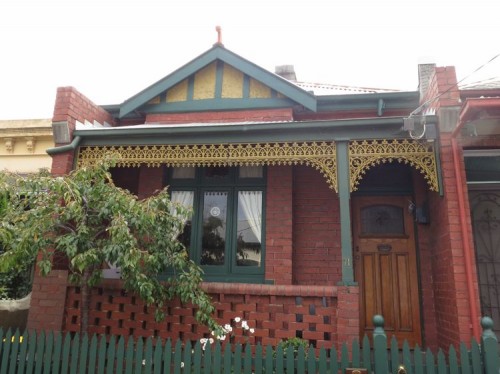
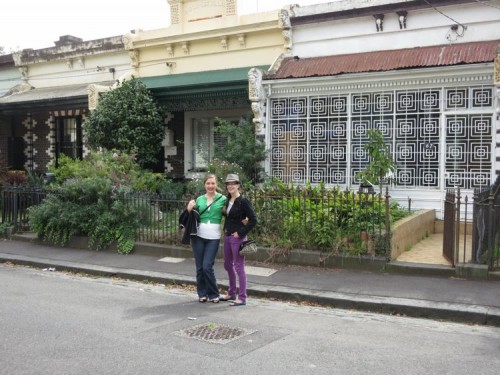

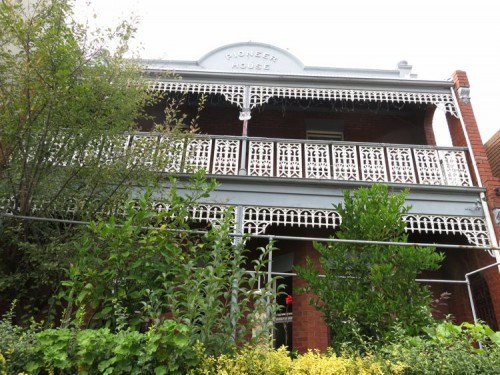
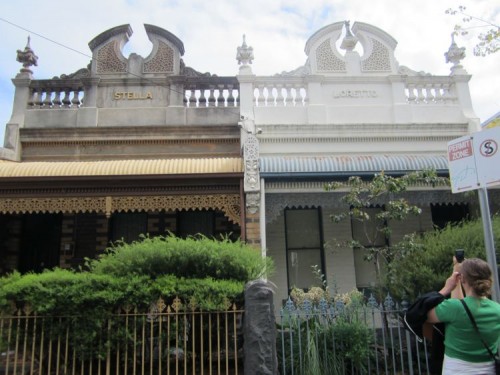
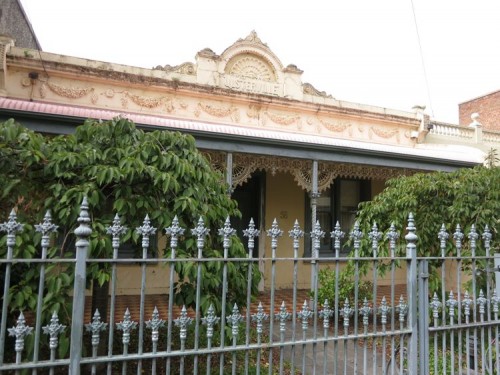
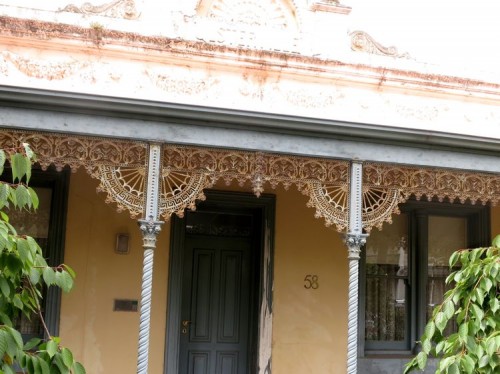
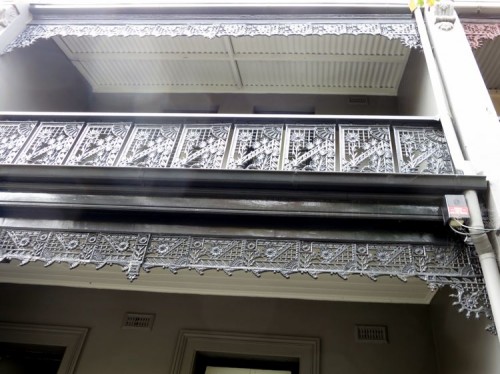
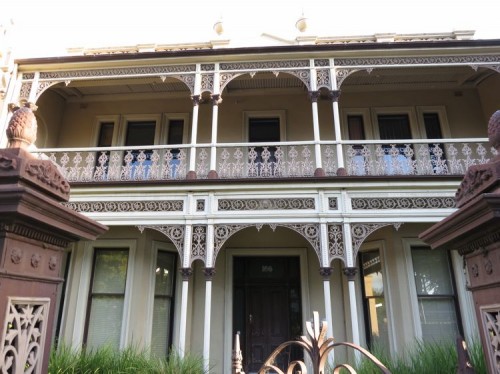
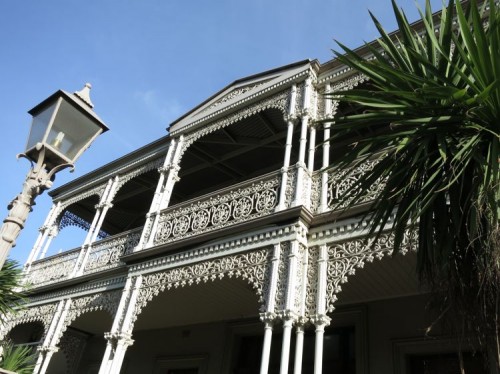
That is so pretty! It reminds me a LOT of New Orleans. IIRC that wrought iron was done there, and not imported. Although New Orleans wrought iron is a bit more baroque in style; some of these remind me of 19th century things. As you say, like later Victorian wooden house trim, “gingerbread.” The Greek Key in particular showed up everywhere in fashion by the 1860s. Oh – New Orleans has an extremely humid climate, as well, and it doesn’t seem to have done the wrought iron much harm; so I wouldn’t think that’s the reason New Zealand opted out of the trend!
I love how different Australian architecture is to ours. The influences I have always understood to be far more European than British, as the balance of immigration to there was much higher from Europe itself. But I never thought much more about it than that!
It is also interesting I think, that here everyone got a house and a section, because that was the game – immigrate and get some space. Whereas in urban Oz, there are still heaps of teeny terrace houses. Given the huge amount of space, clearly the mindset was very different. I hope you get some insights about it all while you are over there! 🙂
Wow–can you recommend a NZ book, Mrs. C? Ever since teaching ESL class where I got the full grasp of my American-bred ignorance (Dido’s most important acts took place in Tunisia–Africa! I guess I had assumed she was European ie White), I’ve been getting books left and right to bone up.
NZ reminds me of the way Canada was first settled. What happened when homesteads had children? Were the parcels divvied up?
It’s just gorgeous! I’ve never seen anything quite like it.
Okay, sticking my neck out here, but I think fretwork is made of wood, with a fret-saw or mecanical equivalent. This lovely stuff is ironwork. Poured and moulded rather than wrought, which involves lots of hammering and the use of big pliers. I love it. It’s like the gilding on gingerbread.
New Zealand did have it, on houses of similar age, but so many of them have been knocked down, it is hard to find. I may be wrong (neck well extended here) but I think a lot of it was imported (NZ not iron rich) whereas Australia may well have been processing her own ore. There was also the problem of the wars. Because we were short of iron, many metal fences and fiddly bits were melted down, though not to the same extent as in the UK.
Wonderful photos! Charming houses!
Ah, I bet you are completely right! Architecture isn’t my area.
amazon.comI’ve been having a wee worry about the iron lace being made from pig iron used as ballast. Just didn’t seem likely that the UK which imported iron would re-export it as ballast without ‘adding value’ in some way. And a bit of googling brought up this…
http://mileslewis.net/australian-building/pdf/08-metals/8.07-ornamental-cast-iron.pdf … which states firmly and with high and authoritative soundings, that the iron lace itself was exported to Australia ( and probably NZ) as a ballast cargo. According to the footnotes, this book is the oracle…
http://www.amazon.com/Australias-Iron-Lace-Brian-Turner/dp/1864482397
Just shows I have too much spare time!
There’s parts of Sydney with houses like this as well and they’re all fairly close to the CBD. I’d guess 1870s, but I’m not really sure why I say that. Interestingly, when trying to Google it I end up here…or at modern fretwork company websites!
Some of these look like ones I’ve seen in Essendon!
There used to be one of those double story houses with the ironwork in Barbados St in Christchurch; unfortunately it was yet another victim of the earthquakes and no longer exists 🙁
Oh no 🙁 How terribly tragic. I wish I had gotten to see more of Christchurch as it was. I just had the most fleeting visit there.
I seem to recall that this cast iron work was a cheaper mass produced alternative to wooden fretwork, while giving much the same look – much like machine lace over the handmade sort.
The late Victorians, of course, proceeded to go completely overboard with it.
I feel lucky I get to live in a neighborhood (Fitzroy) with such amazing houses — each and every day I get to walk by them. I’m only sad my flat is too modern to have it — I would paint it all different colors to accent the beautiful designs!
These houses are beautiful, and they have such personality! Maybe that’s why they got named? Or maybe they were named before streets and numbered houses were used for delivering mail? Anyway, I love that they are such normal names, too, like Stella! The only houses I know of have grandious, pretentious names like Northwingertonhamsmithshire or something.
They are definitely post street names and addresses. I like the idea of them having personality, though really, there are whole neighborhoods of that kind of house! Isn’t Stella a grandiose, pretentious name? I mean, not ‘Upson Downs’ but also not a crisp descriptor like “Green Gables”.
I know this one! Locally, we call it ‘iron lace’ and it is so prevalent because it was made from the pig iron that came to Oz from Britain as the ballast in ships. Local foundaries melted it down and made the lace. I love your tribute to it – alway great to have a visitor remind us just how lovely it is!
How fascinating – recycled ballasts. What a brilliant thing to do with them – so much beauty and joy out of something so mundane!
It’s like icing for houses! I love stuff like that–I would especially love gardens and greenhouses all decked out in it. Maybe I should just invent a time machine and go back to the Victorians where I belong.
Yup…I’m with you there. Look at Victorian photos of city streets and then google map the same location. You could just weep when you see the gaudy junk that has replaced them, or worse, covered them! No character. And women’s clothing…decoration has been replaced with skin. I’ll grant that doing my job in a bustle skirt would be a challenge…may be modern clothes are more practical…but, they are not prettier!
Icing for houses! Brilliant!
I love the past, but I don’t mind living now – it gives me the chance to explore all sorts of pasts.
Oh it was very popular with the late victorians in NZ, all over the front of the wooden villas…. but then in about the 20s it became SERIOUSLY unfashionable, and was all pulled off!!! Criminal, eh? But I suppose it was also the depression, and a pretty trim on your house could be melted down and sold to buy bread 🙁
I thought it must have been, but I just can’t understand how it ALL disappeared. Surely one or two houses must have been spared. After all, Melbourne is literally dripping in it, and they had the depression and WWI and WWII too.
If you go to Dunedin, there are still villas and terrace houses with ironwork 🙂
Hmmmm…. I’ve spent a little time in Dunedin. Trying to remember if I saw any. I wonder why it would have lingered there and not elsewhere?
Well Dunedin and Melbourne were both ‘Gold Rush’ cities at the same time and same area of the world. But obviously it never stuck around in Dunedin as much as in Melbs! Dunedin is pretty close to the sea, as well. Actually apart from Hamilton, every city in NZ is by the sea.
It’s hard not to be close to the sea in NZ 😉 Go too far away from the coast and you just end up at the other coast!
We’re not just damper; we’ve got more salt on the breeze. We had this, but it rusted, because the salt breezes killed it.
That’s exactly what I thought. I know that Hawaii has the same problem!
(I think of it as ‘iron lace’ too. If one Googles for the term, and ignores the women with motorcycles, one finds a lot of images of it.)
Ah, the perfect description! It seems to be the preferred Australian term – most of the sites with images are out of Sydney.
This Tucson native is back in the southwest! Albuquerque has much decorate ironwork in the mission style. Best of all, there are still many artisans who create it here. (http://barnettaldon.com/)
Some of it is as fancy as Australian, but it goes over windows and doors, here, rather than the gingerbread style, so you could keep the windows open and stay safe.
The names are just wonderful. What would you name your house?
In South Africa we call it “broekie lace” which directly translates as “panty lace”. As in lace underwear for houses 🙂
Hahahahahahaha!
🙂
That is hilarious!